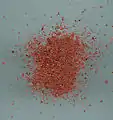Rhus coriaria
Rhus coriaria, commonly called Sicilian sumac,[3] tanner's sumach,[4] or elm-leaved sumach, is a deciduous shrub to small tree in the cashew family Anacardiaceae. It is native to southern Europe and western Asia.[2] The dried fruits are used as a spice, particularly in combination with other spices in the mixture called za'atar.
| Rhus coriaria | |
|---|---|
 | |
| Scientific classification | |
| Kingdom: | Plantae |
| Clade: | Tracheophytes |
| Clade: | Angiosperms |
| Clade: | Eudicots |
| Clade: | Rosids |
| Order: | Sapindales |
| Family: | Anacardiaceae |
| Genus: | Rhus |
| Species: | R. coriaria |
| Binomial name | |
| Rhus coriaria | |
| Synonyms[2] | |
| |
Cultivation
The plant will grow in any type of soil that is deep and well-drained.[5]
Uses
The fruit has a sour taste; dried and crushed, it is a popular spice in the Middle East.[5] Immature fruits and seeds are also eaten. Mature fruits were also known well before lemons to the Europeans since the times of the ancient Romans, who appreciated its sourness and used it in vinaigrettes like lemons in modern times. It is traditionally used and also clinically investigated for lipid lowering effects.[7]
The leaves and the bark were traditionally used in leather tanning and contain tannic acid.
Dyes of various colours, red, yellow, black, and brown, can be made from different parts of the plant.[5]
Oil extracted from the seeds can be used to make candles.[5]
Images
 Cultivated R. coriaria, with olive trees, in Spain
Cultivated R. coriaria, with olive trees, in Spain Spice (ground fruit) for sale in Istanbul
Spice (ground fruit) for sale in Istanbul Spice, close-up
Spice, close-up
References
- Participants of the FFI/IUCN SSC Central Asian regional tree Red Listing workshop (2007). "Rhus coriaria". IUCN Red List of Threatened Species. 2007: e.T63485A12667115. Retrieved 22 May 2020.
- "Rhus coriaria". Plants of the World Online. Royal Botanic Gardens, Kew. Retrieved 22 May 2020.
- "Rhus coriaria". Natural Resources Conservation Service PLANTS Database. USDA. Retrieved 21 October 2015.
- "BSBI List 2007". Botanical Society of Britain and Ireland. Archived from the original (xls) on 2015-01-25. Retrieved 2014-10-17.
- Plants for a Future database accessed August 2010
- Oxford English Dictionary, 3rd edition, September 2019, s.v.
- Hajmohammadi, Zahra; Heydari, Mojtaba; Nimrouzi, Majid; Faridi, Pouya; Zibaeenezhad, Mohammad Javad; Omrani, Gholamhossein Ranjbar; Shams, Mesbah (2018). "Rhus coriaria L. Increases serum apolipoprotein-A1 and high-density lipoprotein cholesterol levels: A double-blind placebo-controlled randomized clinical trial". Journal of Integrative Medicine. 16 (1): 45–50. doi:10.1016/j.joim.2017.12.007. PMID 29397092.
